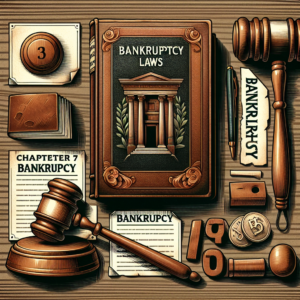
In recent years, the complexities surrounding bankruptcy lawsuit settlements have garnered significant attention, revealing a landscape fraught with misconceptions and legal intricacies. As individuals and businesses alike grapple with financial distress, understanding the nuances of bankruptcy laws becomes paramount. This article aims to unveil the truth behind bankruptcy lawsuit settlements, exploring key concepts, legal frameworks, common myths, influencing factors, real-life case studies, and essential steps for navigating the process.
Understanding Bankruptcy Lawsuit Settlements: An Overview of Key Concepts and Terms
Bankruptcy lawsuit settlements refer to the resolution of disputes arising from bankruptcy filings, often involving creditors and debtors negotiating terms to satisfy outstanding debts. Key concepts include “debtor,” the individual or entity filing for bankruptcy; “creditor,” the party owed money; and “automatic stay,” a legal provision that halts all collection activities upon filing for bankruptcy. Settlements may involve debt discharge, repayment plans, or asset liquidation, depending on the type of bankruptcy—Chapter 7, Chapter 11, or Chapter 13. Understanding these terms is crucial for individuals navigating the often-overwhelming bankruptcy landscape.
The Legal Framework: How Bankruptcy Lawsuits Are Governed in Different Jurisdictions
Bankruptcy laws vary significantly across jurisdictions, with each region establishing its own legal framework to govern bankruptcy proceedings. In the United States, federal law predominates, primarily outlined in the Bankruptcy Code, but states have the authority to enact laws that may influence exemptions and procedural aspects. Internationally, countries like Canada and the United Kingdom have their own bankruptcy regulations, which can differ in terms of debtor protections and creditor rights. This legal diversity necessitates a thorough understanding of local laws for individuals and businesses facing bankruptcy, as the implications of these laws can dramatically affect settlement outcomes.
Common Misconceptions: Debunking Myths Surrounding Bankruptcy Settlements
Despite the increasing prevalence of bankruptcy, numerous misconceptions persist, clouding public understanding. One common myth is that filing for bankruptcy equates to financial failure or irresponsibility; however, many individuals face unforeseen circumstances, such as medical emergencies or job loss, that lead to bankruptcy. Another misconception is that all debts are dischargeable; in reality, certain obligations, such as student loans and tax debts, may remain after bankruptcy proceedings. Additionally, some believe that bankruptcy settlements are always unfavorable for debtors, when in fact, negotiated settlements can provide a fresh start and a manageable path to financial recovery.
Analyzing the Factors Influencing Bankruptcy Settlement Outcomes and Their Implications
Several factors influence the outcomes of bankruptcy settlements, including the debtor’s financial situation, the nature of the debts, and the willingness of creditors to negotiate. The debtor’s income, assets, and overall financial health play a crucial role in determining what settlements are feasible. Creditors, motivated by the desire to recover as much of the owed amount as possible, may be open to negotiations, especially if they perceive that pursuing litigation would yield lower returns. Additionally, the legal representation of both parties can significantly affect settlement negotiations, as experienced attorneys can advocate effectively for their clients’ interests. Understanding these factors is essential for debtors seeking favorable outcomes in bankruptcy settlements.
Case Studies: Real-Life Examples of Bankruptcy Lawsuit Settlements and Their Consequences
Examining real-life case studies can provide valuable insights into the complexities of bankruptcy lawsuit settlements. One notable example is the case of General Motors, which filed for Chapter 11 bankruptcy in 2009. The company successfully negotiated settlements with various creditors, resulting in a restructuring plan that allowed it to emerge from bankruptcy with a more sustainable business model. Conversely, the case of Lehman Brothers illustrates the challenges of bankruptcy settlements; the firm’s collapse in 2008 led to protracted legal battles and complicated settlements that affected thousands of creditors. These cases highlight the diverse outcomes of bankruptcy settlements and the far-reaching consequences they can have on individuals, businesses, and the economy as a whole.
Navigating the Process: Essential Steps for Individuals Facing Bankruptcy Lawsuit Settlements
For individuals facing bankruptcy lawsuit settlements, navigating the process can be daunting. The first essential step is to seek professional legal advice from an attorney specializing in bankruptcy law. This guidance is crucial for understanding rights, obligations, and potential outcomes. Next, individuals should gather all relevant financial documents, including income statements, tax returns, and lists of debts, to provide a comprehensive overview of their financial situation. Engaging in open communication with creditors can also facilitate negotiations, as transparency often leads to more favorable settlement terms. Finally, individuals must be prepared to explore various settlement options, such as debt repayment plans or asset liquidation, to find the most suitable path toward financial recovery.
In conclusion, the landscape of bankruptcy lawsuit settlements is complex and often misunderstood. By gaining a deeper understanding of key concepts, legal frameworks, and the factors influencing settlement outcomes, individuals can better navigate this challenging process. Debunking common myths surrounding bankruptcy can also empower debtors to approach their financial situations with clarity and confidence. As demonstrated through real-life case studies, the implications of bankruptcy settlements can be profound, underscoring the importance of informed decision-making and professional guidance in achieving favorable outcomes.




















